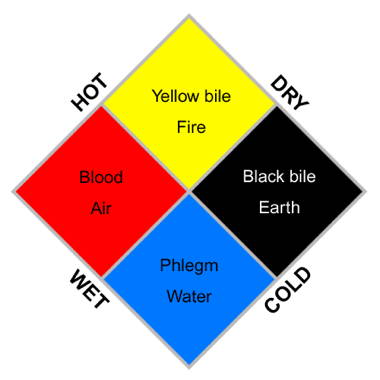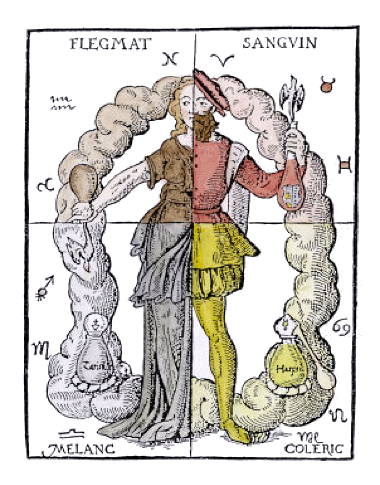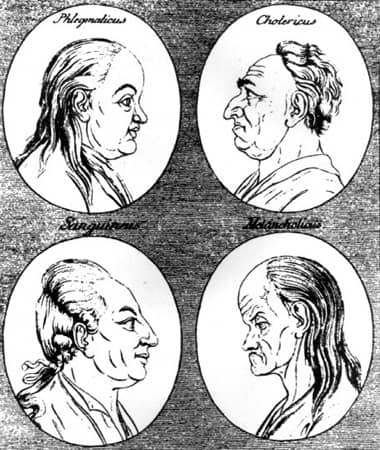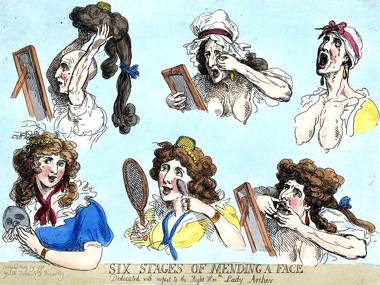Complexion
Every morning, millions of people apply cosmetics – like a moisturiser or foundation – to fix and/or minimise imperfections in their complexion. We all know that cosmetics have an extended history that goes back to prehistoric times but what is less well known is that the idea of a ‘complexion’ also has a long story.
The term ‘complexion’ originally comes “from the Latin con (with or together) and plectare (to plait or twine)” (Connor, 2004, p. 19). The reason for this is that it was originally regarded as the surface manifestation of the interaction between the body humours.
Body humours
In the West, the concept of body humours was developed by the ancient Greeks and Romans and then passed down through the ages as an explanation of disease. It was based on the idea that everything in the world was made up of four elements – earth, fire, water and air – and that there were four body fluids, called humours – blood, phlegm, black bile, and yellow bile – that corresponded to each of these four elements.
The humours were thought to be in a constant state of flux and affected by factors such as diet and activity. Their presence and imbalance was believed to effect a person’s health, even determining what we would now refer to as personality, temperament or disposition; e.g., too much black bile would make you melancholic. Traces of this thinking can still be found in our language today when we talk of people being ‘cold’ or ‘hot tempered’.
When physicians of the Middle Ages looked at a person’s skin, they saw it not as a thing in itself, but rather, as the outward sign of the state of the body’s humours, as a complexion of the four body fluids. They examined it for signs of imbalance, with skin blemishes being seen as places where excess humours were trying to get out. The colour of the skin was considered to be particularly important, as an excess of any one colour – red, black, white or yellow – could be related to an overabundance of one of the four humours.
Should such signs be found, then the physician’s job was to rebalance the humours – through herbal remedies, emetics, purges, fasting and/or changes to the diet– or to open an escape path for them – through blood-letting, blistering or scarification of the skin – so that those making the person sick could be cleared.
Although the humoural theory dominated medical thinking up until the eighteenth century, by the sixteenth century the use of the term complexion had began to change its meaning. Complexion began increasingly to refer primarily to the “natural colour, texture and appearance of the skin” (The Compact Oxford English Dictionary, 1991) gradually dropping its association with the humours and a person’s temperament. However, the connection between humours and skin problems took a long time to disappear and references to it were still found in the nineteenth century.
We have no doubt, however, that one of the most frequent causes of sunburn is to be sought for in the superabundance of bile which the heat of summer, as well as hot rooms, so often produces.
(The art of beauty, 1825, p. 118)
Complementary medicine
The idea of body humours was not confined to European medicine. It also appears in different forms in India and China and it is from these traditions that it is being reintroduced into the West through Ayurvedic, traditional Chinese, and other complementary medicines. Consequently we have seen a return of the practices of purging and fasting although fortunately, not bloodletting.
Cosmetics
As the humoural theory waned, the word complexion widened its meaning. By the seventeenth century, it had become associated with cosmetics, which were described as being able to ‘give a complexion’ to the face. The strengthening relationship between cosmetics and complexion was accompanied by a lot of masculine concern about ‘natural’ compared with ‘artificial’ complexions. Men of the time were worried that they could be deceived by diseased women using paint and powder to cover up the effects of smallpox and other blemishes or by older women applying it to ‘adjust’ their age so that they appeared to be younger than they really were.
The concern with artificial complexions was still present in Western society at the end of the nineteenth century but by then the application of paint and powder was on the increase and the social stigma associated with using it was declining, a process that accelerated in the twentieth century. By the 1960s, the use of make-up was so culturally entrenched that we do not think of it as odd that it could be even be applied to create a ‘natural look’.
Updated: 26th January 2017
Sources
The art of beauty. (1825). London: Knight and Lacey.
The compact Oxford English dictionary, (2nd ed.). (1991). Oxford: Clarendon Press.
Connor, S. (2004). The book of skin. London: Reaktion Books.

The four body humours: Blood, hot and wet (air); Phlegm, cold and wet (water); Yellow bile, hot and dry (fire); and Black bile, cold and dry (earth).

The four temperaments.

Human facial characteristics based on the four temperaments.

1792 Six Stages of Mending a Face by Thomas Rowlandson [1756-1827].

A present day ‘natural complexion’ created with cosmetics.
